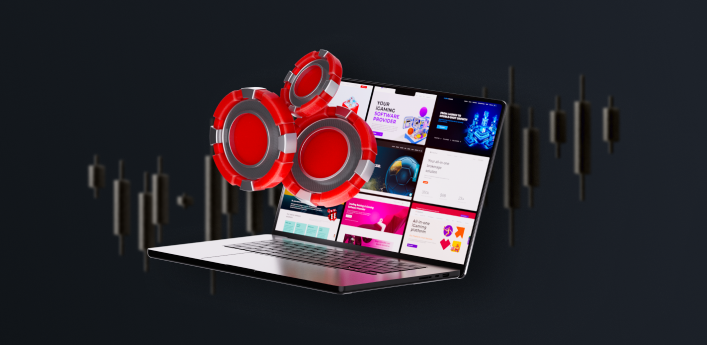
¿Qué es Broker CRM? Qué es y cómo funciona
Contenidos
En pocas palabras, el CRM es un sistema de relaciones. Su objetivo es almacenar registros sobre los clientes y todas sus interacciones con ellos para establecer relaciones, generar registros sobre clientes potenciales y tomar medidas para convertirlos en ventas y entregas. El CRM permite realizar un seguimiento de todas las etapas de la relación y las actividades del cliente.
CRM de corretaje El sistema es una herramienta organizativa para configurar y rastrear la actividad de ventas y los recursos de intermediación administrados por el back office y necesarios para el éxito del cliente y la entrega de un producto o servicio al cliente como ejecución de una venta.
CRM de corretaje: herramienta para el almacenamiento eficiente de datos de ventas y la comunicación entre la atención al cliente y el back office para lograr los resultados prometidos a los clientes de la manera más eficiente. Esto se traduce en una satisfacción y fidelización continuas de los clientes.
¿Por qué las organizaciones de corretaje están estructuradas para Front y Back offices?
Los ingresos son un objetivo de actividad para toda organización mercantil establecida con fines comerciales. El objetivo de ganancias se logra gestionando los recursos disponibles y destinándolos a actividades útiles mediante la gestión de procesos, personal, sistemas de información, instalaciones y fuentes de datos.
La gestión es una forma o actividad para establecer objetivos, organizar el flujo de procesos y ejecutar una estrategia empresarial determinada con el fin de obtener beneficios de la acción. La dirección se traduce en beneficios o en el impacto esperado en los procesos de la organización. Esta es una actividad racional para los negocios y requiere una ejecución fluida de la estrategia y las tácticas dentro de una estructura determinada.
Proceso de gestión dentro de la organización de corretaje:
- Planificación: establecimiento de objetivos estratégicos o tácticos que se deben alcanzar. Los objetivos deben ser medibles para monitorear el desempeño y confirmar su cumplimiento.
- Organización: establecimiento de estructura, recursos y limitaciones para que el equipo sea capaz de alcanzar los resultados planificados.
- Ejecución: finalización de una tarea o conjunto de tareas a realizar para alcanzar un objetivo estratégico o provisional de la organización.
- Controles: conjunto de limitaciones dentro de las organizaciones, retroalimentación y gestión de esfuerzos para alcanzar los objetivos de la organización.
Una organización es un grupo de personas con una estructura establecida para impulsar los resultados empresariales de forma fluida y organizada, logrando así sus objetivos y la rentabilidad del negocio. La organización necesita estructura para comunicarse y lograr controles y retroalimentación eficientes entre las personas.
La estructura organizacional puede ser: Funcional, Divisional, Matriz, Equipo, Red, Jerárquica, Plana, Miscelánea.
Más del 80% de las organizaciones utilizan estructuras jerárquicas (lineales) y funcionales. Esto hace que los procesos de toma de decisiones sean más transparentes y los riesgos más manejables. Las estructuras menos estrictas se centran en el trabajo creativo (ágil), pero consideran más la fragilidad ante factores externos, aunque resultan gratificantes en la generación de nuevas ideas para productos.

¿Qué es el enfoque Front office y Back office dentro de la estructura de la organización?
En la industria financiera, en aras de la transparencia y la gestión de riesgos, la estructura de las organizaciones de corretaje generalmente se divide en Front office, Middle office y Oficina administrativa El número de empleados y la infraestructura son factores importantes. Esto significa que este enfoque se aplica a las estructuras organizativas de la mayoría de las empresas de acciones, FOREX, CFD y... opciones binarias corredores, distribuidores y miembros compensadores, tanto para operaciones basadas en lugares de intercambio/ecn como cuerpos de cadetes militares .
Oficina principal – customer faced employees and infrastructure. Oficina principal mainly deals with sales and trading and is a part of organization structure that comes in contact with clients to attract customers. Mostly activity comes from marketing, sales and shared services departments.
Oficina intermedia – Tecnologías de la información, atención al cliente y gestión de riesgos.
Oficina administrativa – administrative, customer care and payment services. That is the place where work is done to support front office operations. Oficina administrativa is the set of resources which are allocated for creating a product or service and are not observed directly by customers during delivery period.
La comunicación es muy importante en toda organización y en las financieras permite una eficiente cooperación en front y back office y establece en todas estas etapas un proceso manejable que es la forma adecuada de alcanzar los resultados esperados.
La estructura de la organización financiera está conectada mediante la comunicación, el intercambio de información y la interacción significativa entre los participantes. La dirección se ejecuta mediante órdenes directas, datos y retroalimentación que recopilan información sobre los resultados de acciones previas.
¿Qué es un Back office de Brokerage?
Brokerage Back office es un módulo único que recopila flujos de datos de la API relacionada con las ventas y almacena datos en forma de documentos o registros de datos.

¿Cuándo comienza la historia de la división de las organizaciones financieras en Front y Back offices?
Las oficinas administrativas surgieron en el siglo XIX entre los operadores de oro y valores para facilitar la contabilidad eficiente y la gestión de posiciones en contratos con exposición destacada a vencimientos definidos. Posteriormente, se configuró como oficina administrativa para corresponder a las credenciales individuales del cliente para una contabilidad adecuada y, en el medio, las comunicaciones telefónicas y por teletipo, posteriormente reemplazadas por las tecnologías de la información y las herramientas de gestión de riesgos. La mayor parte de la comunicación en las plataformas de intercambio se ejecuta mediante protocolos específicos como FIX/FAST, lo cual no es necesario para instrumentos OTC como CFD, opciones binarias, derivados dentro de la compensación o mesas bancarias de una sola institución donde el comprador y el vendedor realizan operaciones dentro de la misma institución.
¿Cómo Broker CRM opera los datos?
El CRM almacena datos de corretaje principalmente en formato no verbal, visual y cuantitativo, lo que permite al equipo tomar decisiones rápidas e informadas y reducir la asimetría de información en su organización. Por eso, un sistema CRM es fundamental para el éxito de la empresa. El CRM es parte integral de cada área administrativa de la empresa. El CRM optimiza las operaciones de corretaje y facilita que los clientes alcancen sus objetivos, ofreciendo la infraestructura y los recursos necesarios para que el producto o servicio vendido se entregue eficientemente al cliente, con la máxima satisfacción del cliente y alcanzando los objetivos comerciales, para ser rentable y reconocido por una mejor ejecución.
¿Por qué es tan importante el sistema Broker CRM para las comunicaciones entre el Front y el Back office de una correduría?
La comunicación se basa en información interna y externa y se utiliza para una toma de decisiones eficiente, reduciendo el riesgo de incumplimiento y aumentando la eficiencia del ciclo de retroalimentación interno. Una comunicación eficiente se basa en una menor asimetría de la información, lo que implica un intercambio rápido y eficiente de información entre los miembros de la organización.
La comunicación se realiza mediante intercambio de datos verbal, no verbal, visual y escrito. Puede mejorar la comunicación dentro de su organización de corretaje mediante el uso de sistemas CRM para el seguimiento de la actividad de ventas y el almacenamiento de registros en la oficina administrativa. El equipo de ventas se comunica principalmente verbalmente con los clientes y registra los datos en el CRM para proceder a la atención al cliente.
¿Cuáles son las características clave del sistema Broker CRM?
- Almacena el perfil del cliente
- Almacena datos KYC del cliente
- Registros de actividad y generación de clientes potenciales
- Realiza un seguimiento del historial de interacciones y compras de los clientes.
- Herramienta sofisticada de análisis y generación de informes
- Herramienta de marketing y ventas para la colaboración en equipo
- Reduce los costos de mantenimiento del back office
- Mejora significativamente la comunicación interna y el intercambio de información a nivel formal e informal
¿Cuáles son los principales beneficios de utilizar el sistema Broker CRM en el Back office?
- Perfiles unificados de clientes
- Identificación del cliente de acuerdo con las normas de cumplimiento
- Aumentar la productividad del equipo de ventas
- Construir mejores relaciones y retención de clientes
- Informes y análisis
- Colaboración en equipo
- Las comunicaciones eficientes dentro de su correduría serán el resultado de una implementación exitosa del sistema CRM:
- El intercambio rápido de información es importante para el desarrollo empresarial
- Mejores relaciones con los clientes
- Bucle rápido de retroalimentación interna para la toma de decisiones
- Comunicación externa rápida
- Mitigación de conflictos por falta de acceso a la información
- Mayor compromiso de los empleados
- Productividad mejorada
- Crea una cultura laboral más saludable
- Dirección eficiente de empleados
- Mayor satisfacción laboral
- Innovación e intercambio de ideas
- Formación de equipos

El sistema CRM de corretaje es el medio por el cual el back office se comunica con la recepción para lograr la satisfacción y fidelización de clientes. La recepción de la corretaje vende sus productos y registra la actividad en el CRM. El equipo de back office utiliza el CRM como recurso para la atención continua al cliente y la entrega de los productos vendidos. La recepción de la corretaje promociona y vende los productos, mientras que el back office organiza la entrega continua y la calidad del servicio. La correcta prestación del servicio de corretaje por parte del back office establece una conexión con los clientes, lo cual es la base para la fidelización y para generar ventas entrantes adicionales.
¿Qué partes del sistema CRM se utilizan para la actividad de front office de corretaje?
- Módulo de ventas
- Módulo de informes
- Herramientas de comunicación
- Herramientas de marketing
Los sistemas CRM generalmente incluyen, integran o ubican conjuntamente capacidades de centro de contacto que benefician la intermediación con:
- Mayor eficiencia y productividad
- Experiencia de cliente personalizada
- Soporte optimizado
- Mejora del rendimiento del personal

Componentes del centro de contacto utilizados para CRM y que están integrados con los registros de Back office:
- VoIP – voz sobre internet
- CTI – Integraciones de telefonía informática
- Cola de llamadas: llamadas entrantes con el cliente
- ACD: distribución automática de llamadas según enrutamiento basado en habilidades o prioridades
- IVR - respuesta de voz interactiva
- Grabaciones de llamadas: mayor garantía de calidad
- Análisis de datos: medición de KPI
- Integración de CRM: la puerta de enlace es imprescindible
- Integración de CPD: almacenamiento de la plataforma de datos de clientes
- Chats: comunicación directa con el agente de soporte
- ChatBots: un programa impulsado por IA
¿Qué componentes del sistema CRM son críticos para el back office de una empresa de corretaje?
El elemento funcional clave del sistema CRM de Brokerage es almacenar Conozca a su cliente (Conozca a su cliente) datos como elemento central del marco de cumplimiento dentro de la organización.
Conocer la actividad de sus clientes consiste en un conjunto de acciones para identificarlos, verificarlos y almacenar estos datos en un sistema de almacenamiento confiable, un componente típico de un sistema CRM conectado a las instalaciones de datos del back office. La actividad KYC es un requisito de los reguladores, según el marco legal vigente en el lugar donde opera la empresa de corretaje. Los estándares KYC son establecidos por organizaciones internacionales y, en ocasiones, con la ayuda de equipos de asesoría legal sin fines de lucro que actúan en nombre del gobierno local o del banco central.
Un componente clave del KYC es el programa de identificación del cliente, que se basa en la recepción de documentos clave del cliente para comprobar su identidad y puede utilizar herramientas automáticas y API especializadas de terceros. Los procedimientos KYC, gestionados por los empleados de back office, y sus resultados se registran en el sistema CRM como parte del perfil del cliente o, si es necesario, en software propietario si la institución lo solicita debido a una visión específica o una estrategia accionarial. El desarrollo de software CRM propietario o interno resulta extremadamente costoso y solo se utiliza en casos especiales y muy específicos que requieren seguridad especial o herramientas específicas para el dominio.
Componentes clave de los procedimientos KYC/AML de Broker CRM según Thomson Reuters:
- Programa de identificación de clientes (CIP)
- Debida diligencia del cliente
- Debida diligencia mejorada
- Monitoreo continuo
- Informes y cumplimiento
La diligencia debida reforzada sólo se podrá exigir en los siguientes casos:
- El individuo proviene de naciones sancionadas
- Poseer una empresa fantasma
- Patrones de transacciones inusuales
- Tiene un historial financiero cuestionable
- Asociado con personas o empresas que se sabe que están involucradas o son sospechosas de estar involucradas en actividades ilegales
- Tiene historial de sanciones o transacciones no conformes
- Tiene deudas o gravámenes impagos

¿Cuáles son los principales beneficios de utilizar Brokerage CRM como parte de su oficina comercial integrada?
El uso de Brokerage CRM como parte de su conjunto de herramientas de back office en general y de manera absoluta conducirá a cambios beneficiosos en su equipo y en las relaciones con los clientes:
- Intercambio activo de ideas
- Transparencia de los resultados empresariales
- Bucle de retroalimentación eficiente
- Tareas claras y concisas
- El flujo de datos es consistente y programado
- Reducción de costes
El sistema CRM permite que el back office de corretaje se alinee con las solicitudes entrantes de los clientes para lograr la simetría de información con el front office, manteniendo las operaciones en el mismo flujo de datos eficiente. Esto optimiza la comunicación con los clientes y facilita la entrega inmediata de productos. El CRM para corredores proporciona retroalimentación rápida para todos los procesos de negocio, centrados en la entrega del producto al cliente mediante mejoras continuas y el conocimiento de la experiencia del usuario, lo que permite la retención de clientes de corretaje a menores costos.
Actualizado:
27 de mayo de 2025



